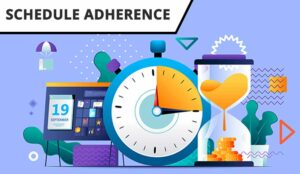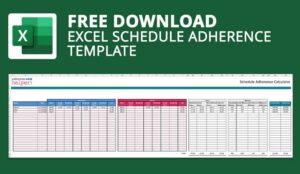We asked our readers and selected industry professionals for their top tips to improve schedule adherence in the contact centre.
1. Build Adherence Into Employee Goals
According to Cormac, another of our readers, “adherence needs to be in the employees’ performance goals. This will ultimately drive accountability for them meeting their adherence goal.”

Yet Andy Hughes, a Contact Centre Operations Manager, goes one step further, suggesting: “I think it also needs to be included in the team managers’ goals/commission structure.”
“Team managers should have an idea when their agents went on break. Their advisors are more likely to make it back on time if they know their manager knows when they went.”
By setting adherence as a goal, you can emphasise its value to the team, while adding it to the team leaders’/managers’ goals can also highlight that the responsibility for adherence doesn’t lie solely with individual advisors, but with management too.
2. Manage Adherence in the Moment
It is simple to measure adherence in retrospect – by simply using the formula that is highlighted below. But, Penny Downs, an experienced Contact Centre Manager, believes that there is real value in managing schedule adherence in real time.

Penny says: “It must be measured consistently, owned by the individual and their team leader, built into performance and reward matrices.”
“Adherence must be managed in the moment, fed back the next day, but, most importantly, everyone should understand why it is important and the impact on their colleagues and customers when it is not met.”
Good telephony systems can be combined with WFM tools to make it simple for team leaders and resource teams to identify breaches and then address them. These breaches can be quickly reviewed at the start of each day, looking at the previous day’s reports and highlighting non-adherences.
For more on calculating adherence manually, read our article: How Do I Calculate… Schedule Adherence?
3. Measure Adherence in Tandem With Conformance

David Preece, a Customer Success Manager at QStory, advises trying to “measure conformance as well as adherence. This means that while the advisor may lose ‘adherence points’ because they’ve missed a scheduled break through no fault of their own, their ‘conformance score’ will only be affected if they take more than the allotted time for the break.”
In conclusion, David believes that “putting the two measures together is a great way of identifying behavioural issues.”
This is a great method of measuring adherence, but David also urges us to remember that “the happier advisors are to come into work, the more likely they will be to show up on time.”
To find out a way of measuring the happiness of your team, read our article: How to Calculate an Employee Net Promoter Score
4. Set a Reasonable Goal for Schedule Adherence

The idea of contact centre adherence is to encourage advisors to follow the schedule as it was designed. However, there is a risk in putting too much emphasis on sticking to the schedule, as it may take away from the importance of serving customers.
This is according to Andrew Leatherland at GCI, who says that: “Systems should allow exceptions to be entered for good reasons (for example, going late to break because a phone call went long).
This can become cumbersome and lead to a situation where supervisors or WFM staff spend all their time entering exceptions.”
“Presume that schedule adherence won’t be perfect, and that special circumstances will affect everyone equally over time. Therefore, make schedule adherence a useful tool, without spending too much time on it.”
It is therefore better to set a reasonable goal for schedule adherence, perhaps in the 86%-95% ballpark, depending on circumstances.
5. Use Workforce Management Tools to Give Advisors More Control Over Their Schedule

In the past, workforce management (WFM) technology was often used to enforce adherence to a planned schedule. It effectively told an employee that they were scheduled on a roster at 8am on Monday and would be working through to 4 pm.
Today, there is a growing awareness that contact centres can achieve higher levels of contact centre adherence and lower levels of lateness by employing technology to enable employees to take control of their own time.
This is according to Jeremy Payne of Enghouse Interactive, who says that the advancement of WFM tools now means that “staff can now be offered a choice of shifts, with incentives and bonuses in place if they want to take advantage of the less popular times – such as the 8am Monday shift.”
“Interactive dashboards can be made available at the desktop, showing employees how much leave they still have available and empowering them to book holidays themselves.”
6. Treat People Like Adults
Paul, one of our readers, believes that the best way to improve adherence is to “just treat people like adults. Avoid silly conversations with someone who is a minute late!”
Having serious conversations with advisors who are only slightly late can build resentment. Even though lateness is more damaging to contact centres than most other workplaces, there are occasionally unavoidable incidents that hold up advisors.
So, be human with advisors – make sure you treat the team as adults, so advisors don’t feel like they are being undermined. This relationship will likely improve adherence for most, while a strict conversation with advisors who are repeatedly late, reminding them of the damage that lateness has on contact centre operations, may be more appropriate.
You can also think about avoiding schedule dissatisfaction, to improve schedule adherence with your team.
7. Improve Communication From the Top Down
As Safwaan, another of our readers, says: “Roles and responsibilities should be clear from advisors to team leaders, and larger contact centres should have a live call escalation team, who can reach out to advisors personally and discuss adherence issues.”
As part of the roles and responsibilities that should be communicated clearly to the team, the importance of schedule adherence must be stressed. This is because advisors may think that it is fine to turn up five minutes late, as long as they add five minutes onto the end of their shifts. However, contact centres do not work like that.
Advisors may think that it is fine to turn up five minutes late, as long as they add five minutes onto the end of their shifts. However, contact centres do not work like that.
So, advisors should have some insight into the difficulty of creating contact centre schedules. The team should know how their lateness can have such an impact on service level that the workload (and occupancy) of their colleagues increases tenfold. If you have a close team, showing late advisors the impact their lateness has on their teammates could be an effective solution.
This principle is discussed further in our article: The Power of One
8. Empower Team Leaders to Book ad hoc Offline Time
Craig, one of our readers, reported that his contact centre managed to improve adherence from 70% in May 2017 to 93% by year end.
According to Craig, a key part of doing so was by “empowering team managers to book ad hoc offline time through the system so that people are booked out rather than taken off.”
Having a flexible scheduling system which enables advisors to swap shifts is good practice, while having an online community which is monitored by managers allows advisors to do so easily and reduces emails to team leaders who have to act as the “go between”.
As well as this, Craig also encourages resource planning teams to “enable shift/lunch swaps, allowing people to take breaks/lunches when they want, without negatively impacting contact centre performance.”
Want to track adherence in your contact centre? download our free excel schedule adherence template
For more advice on how to improve contact centre schedule adherence, read our articles:
- A Beginner’s Guide to Adherence Management
- How to Manage and Improve Schedule Adherence
- Top Tips for Improving Attendance and Adherence
Author: Charlie Mitchell
Reviewed by: Hannah Swankie
Published On: 16th Oct 2022 - Last modified: 13th Sep 2024
Read more about - Workforce Planning, Adherence, Andrew Leatherland, Andy Hughes, David Preece, Downloads, Editor's Picks, Enghouse Interactive, GCI, Jeremy Payne, Printable, QStory, Scheduling
















